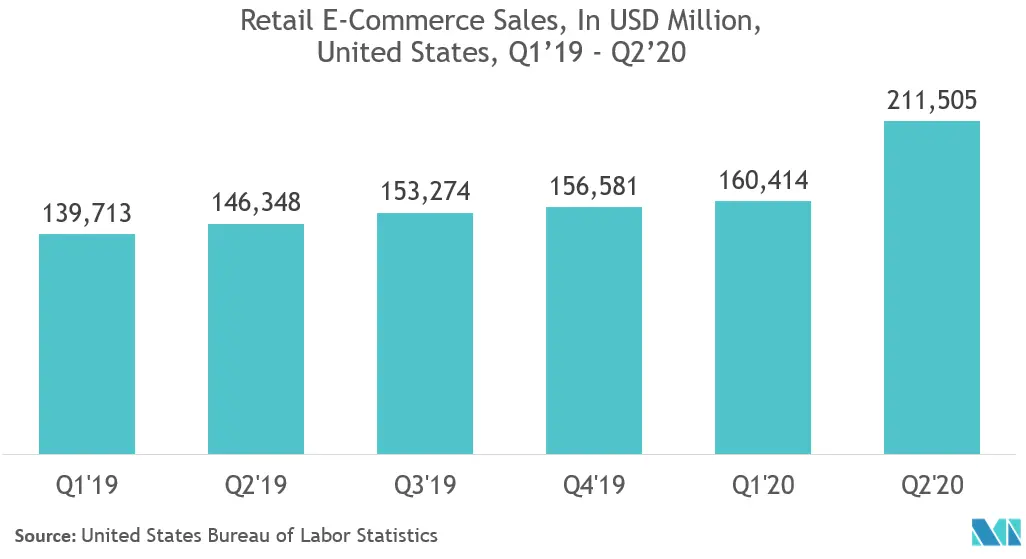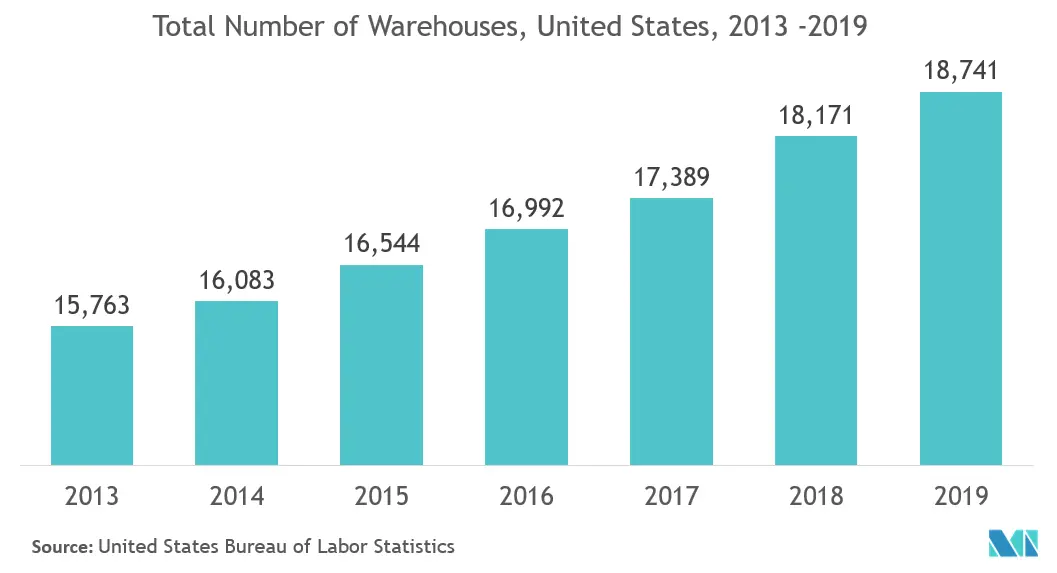Market Trends of North America Conveyors Industry
This section covers the major market trends shaping the North America Conveyors Market according to our research experts:
Retail is Expected to Hold Significant Share
- The significant growth of the United States retail and e-commerce sector and warehouse expansion is becoming a primary driver of market growth. Most of the region's retailers are planning to automate their warehouse establishments, rather than expanding, in such high-priced a rental environment. According to the Robo Business Warehouse Automation Report, almost around 80% of the United States' warehouses are still manually operated. Only 15% of all the warehouse establishments were mechanized, and not more than 5% were automated. This provides a long runway for the conveyor market to grow consistently across the country over the forecast period.
- Retail is one of the major industries, wherein the requirement for conveyors and sortation is essential. It immensely helps online retailers to sort goods and increase good delivery efficiency. Furthermore, retailers are increasingly investing in expanding warehouse space. For example, Blackstone Group invested USD 18.7 billion on 179 million square feet of the US warehouse space to cater to the country's growing retail demand. Amazon.com Inc is another such example, adopting automation techniques to solve its warehouse growing problems. The company is rolling out automated material handling machines and has added many advanced conveyor technologies to its warehouses in recent years.
- In 2019, near to 312 million internet users used the web from the United States, up from almost 287 million in 2017; the United States is one of the biggest online markets globally, ranking only behind India and China in terms of online audience size (Internet World Stats, 2019). With strengthening the logistics network and growing internet penetration, there is significant scope for automation of this region's sector. In the Canadian retail industry, rising labor costs, waning employee productivity, and the need for building more prominent distribution centers to accommodate the increasing number of items being sold in its supermarkets are expected to drive the demand for conveyor solutions.
- The National Retail Federation estimates that sales from over 1 million retail establishments in the United States could reach more than USD 3.8 trillion in 2019. Additionally, retail industry sales are expected to increase between 3.8% and 4.4%, with e-commerce retail sales expected to grow by 10-12% during the forecast period. Numerous growth opportunities exist in the US retail market for retail providers of all sizes, including individual direct sellers or direct marketers, large 'big-box' store operators, and small- to medium-sized franchise unit owners. Such factors are expected to augment the conveyors market in the retail space of the region.

United States is Expected to Hold Major Share
- United States is one of the major investors and innovators in the North American conveyor market owing to the high rate of technological advancements among regional conveyor manufacturers, such as automation, AI, and machine learning, and are rapidly driving the industry forward. Increasing demand for advanced conveyor systems and ever-increasing labor costs with the inconvenience of employing a manual workforce in North America is further driving the US conveyor market.
- The growing adoption of industrial automation to enhance efficiency in the manufacturing and processing sectors is also fuelling the investment in conveying equipment. For instance, the Coca-Cola Company deployed conveyor belts in its manufacturing facilities for bulk handling of products, helped the company increase productivity, and eliminated spillage. The stringent US government regulation for the end-user industry, concerning safety, is also bringing advancement into the market.
- For instance, the FDA Food Safety Modernization Act (FSMA) is expected to transform food and beverage companies by shifting the attention from responding to foodborne illness and foreign material contamination to preventing it. As a result, cleanability and sanity have become the biggest priorities of belt manufacturers in the US. Stainless steel also emerged as a popular belt type for food processing in the country. The US post offices also witnessed a 60% energy savings in parcel-handling applications after employing roller conveyors.
- Space constraints, especially for warehouses and the increasing cost of commercial space leasing, are forcing the US end-user industries to invest in the studied market. According to the Bureau of Labor Statistics, the total number of warehouses in the United States increased from 18,171 in 2018 to 18,741 in 2019. As warehouse spaces' availability diminishes, the demand for conveyor systems in the country is expected to grow significantly over the forecast period.
- With significant growth in the country's end-user industries, most global players are making some alliances or partnerships to expand its presence. For instance, in March 2019, the Finland-based Rocla Oy partnered with UniCarriers Americas (UCA) to offer its solutions to the North American market. Product innovation is still a differentiation factor among the market vendors; hence, the country is witnessing a high product innovation rate.


